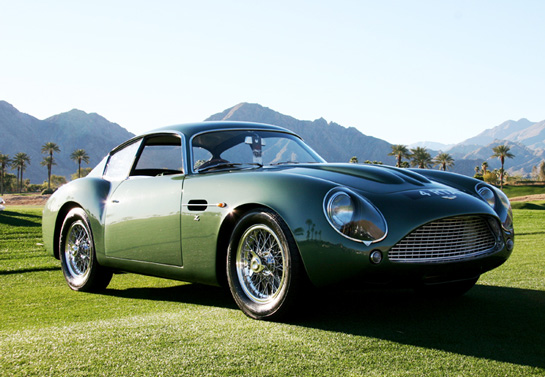
Peter Read’s 1961 Aston Martin DB4 GT Zagato coupe won the Motor Trend Classic Editor’s Choice Award. When asked how he made his choice, Editor Matt Stone said, 'It’s one of the original, real 1961 cars built, it has serious racing pedigree, it’s an Aston Martin, it wears Zagato aluminum tinwork so tightly stretched over its chassis that it fairly pings when you touch it. And oh by the way, it’s supermodel gorgeous, in case you didn’t notice.' Credit John Wylie.
Michael T. Lynch
The fourth edition of the Desert Classic took place at the La Quinta Resort & Club on 27 February. The event is nestled against the Santa Rosa Mountains in the greater Palm Springs area, about 125 miles east of downtown Los Angeles. The entry continues to be among the most diverse of the great American concours.
Organizer Paul Merrigan, a former Pebble Beach Class Winner with a Maserati A6, has a soft spot for Italian cars and his connections in that world showed on the field. In order to leave more room for pictures of the range of French and Italian prize winners and interesting entries, we will concentrate on the Mediterranean component of the show as is in keeping with the focus of this site. That said, we cannot ignore that this year’s Desert Classic had the one of the finest collection of historic Indianapolis 500 cars ever seen. Larry Pfitzenmaier’s Watson roadster won the post-1950 section, with the Malloy Foundation’s Miller-Novi taking the silverware in the pre-1950 portion of the class. Ann Bothwell’s 1916 Indy-winning Peugeot L45 was awarded the trophy for the Most Significant Race Car. Since most historians credit it as being a progenitor of the modern race car, the honor was much deserved. For more on both Larry and Ann’s cars, see the Desert Classic preview from VT’s 16 February edition. Best of Show, Aaron and Valerie Weiss’s 1929 Auburn 8-120 Boattail Speedster was also pictured in that issue. Also shown then was the Petersen Museum’s Ghia-bodied Plymouth Explorer. It won the Post-War Coach Built class. A Maserati not pictured here, Frank Mandarano’s 1960 Maserati 3500 GT Coupe, was first in the Preservation class.
Paul and Holly Merrigan considerably expanded the scope of the event this year, adding a vintage race at Chuckwalla Valley Raceway and bringing EG Auctions aboard for an auction that was conducted during the concours. Casting a wider geographic net for entries, the show continues to gain prestige among collectors and spectators, as well garnering the accolades of the motoring press.
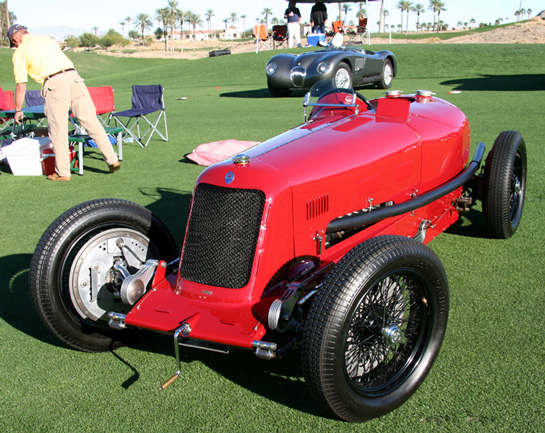
Bill Pope recently did a cosmetic freshening of his magnificent 1933 Maserati 8CM. It must have impressed the judges, as they gave it first place in the International Competition Class.
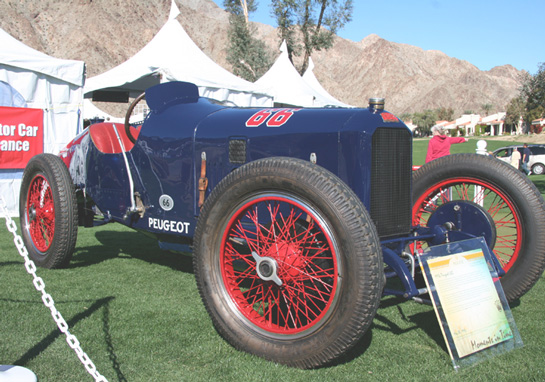
Ann Bothwell’s Peugeot L45 occupied pride of place at one end of the Indy car display. After a day of interviews conducted in front of her, a stream of movie and still photographers and enthralled spectators, the car won Most Significant Race Car. Credit: John Wylie.
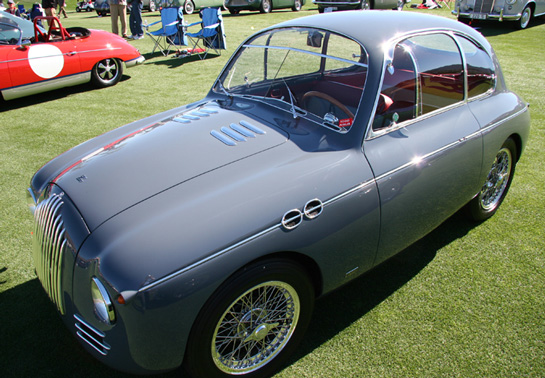
Scott Gauthier’s Fiat 750 MM Zagato Panoramica Coupe won Most Unusual. I’m not sure I would use the word unusual – certainly the car has character. Portholes never looked this good on a Buick Roadbuster. Credit John Wylie.
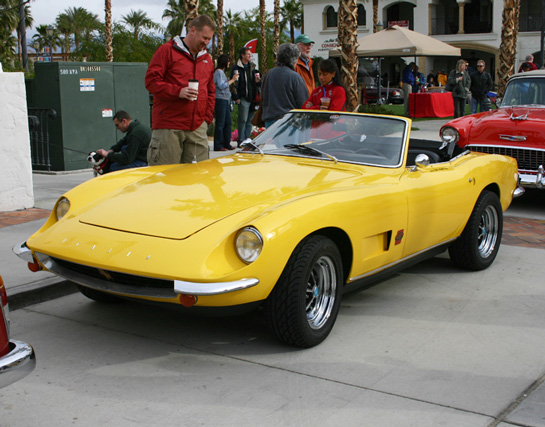
An Intermeccanica waits for the start of the Tour on Saturday morning. These cars had a tortuous family tree. It all began in at the Monaco Grand Prix in 1960. Milt Brown, an engineer from Oakland CA met Frank Reisner, an American-educated Canadian engineer running a company in Italy called Itermeccanica that made speed equipment, auto bodies and complete cars. Brown designed a coupe he called the Apollo GT, powered by the then new Buick 215 c.i. aluminum V-8. Reisner made the bodies and frame at Intermeccanica in Turin and shipped them to Oakland where the engine and GM running gear were installed. Like most small manufacturers, Brown was soon in trouble and the nameplate passed through other owners, while production continued. Finally, all the American distributors went broke and Reisner was left with completed bodies. Some of these received Ford V-8s and Reisner sold them under his Intermeccanica brand, with the coupe called the Italia and the open car called a Turino. As with such operations, things did not always go as planned, and the example seen here has Italia badging. By the time Reisner called it a day, about 750 had been produced. This one is owned by Carl Bomstead. Credit: Michael T. Lynch
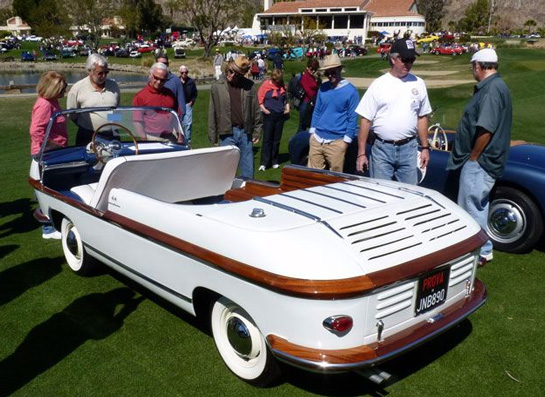
William Cord’s Fiat 600 Multipla-based Eden Roc looks ready for a full day’s cruise up and down the Promenade des Anglais along the Baie des Anges in Nice.. This is another example of the breadth of the Italian and French entry at the Desert Classic. Credit: Orange County Car Enthusiast.
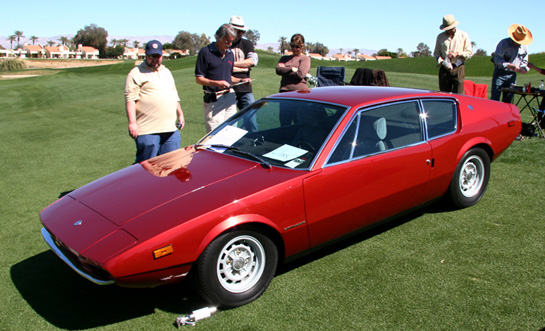
This is the Sinthesis 2000, a one-off show car designed by Tom Tjarda. It is based on a 1970 Lancia Flavia chassis. Tjarda is an American who worked for several Italian design studios, as well as his own. He designed everything from an Innocenti dragster to the Olds-powered Shelby Series 2. The car, now owned by Peter Giacobbi, won the People’s Choice Award at the Desert Classic. Credit: John Wiley
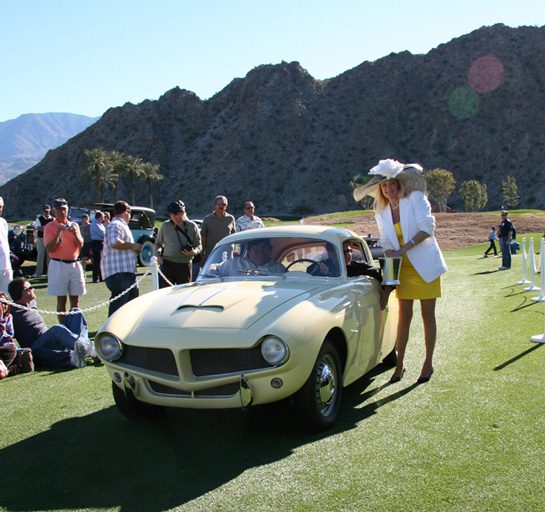
The trophy lady makes the presentation for the best European Sports Car under Two Liters to Joseph Ventura’s Stanguellini coupe. This is based on a Fiat 1100TV with appropriate Stanguellini speed equipment on the Fiat engine. The body is by Bertone during the period when Franco Scaglioni was Chief Designer. If you would like a hat like Anne is wearing, you can contact her business, Anne Albright de Bonrepos Haute Couture Millinery in Calabasis, California. Credit: John Wiley.
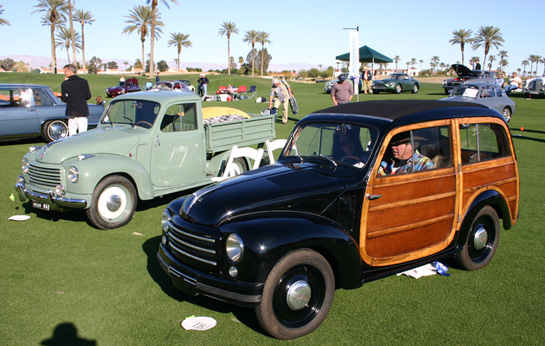
Micro Car Specialist, Mike Malamut didn’t disappoint, bringing these two Fiat 500C Topolinos, a woodie and a pickup. Credit: Michael T. Lynch
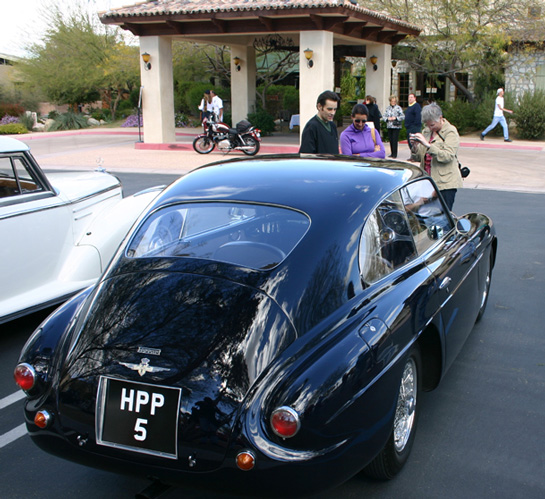
Don and Carol Murray’s Ferrari 166 Touring Berlinetta waits outside the Cuistot Restaurant during the lunch stop on Saturday’s Desert Classic Tour. Don must like this body style because he also has a Ferrari 340 Touring Berlinetta. This car won the Design Team Award as Most significant Closed Car. Michael T. Lynch
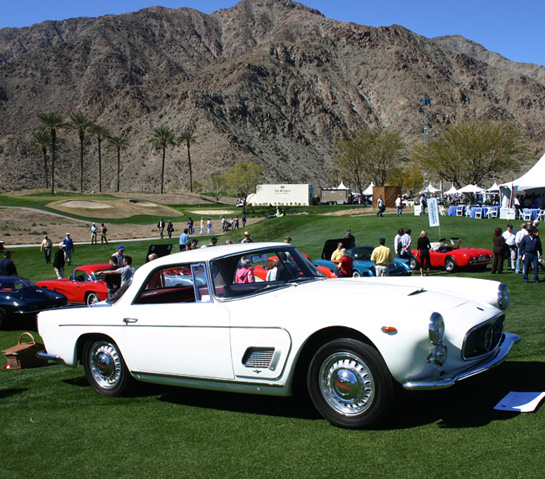
Symbolic Motors brought this pre-production 3500 GT Maserati. The data sheets show that the factory retained this car for almost a year as they made changes to it. Note the special trim, almost certainly an addition to enhance the car’s appearance when it was presented at the Paris Salon in the fall of 1958. Credit: Michael T. Lynch
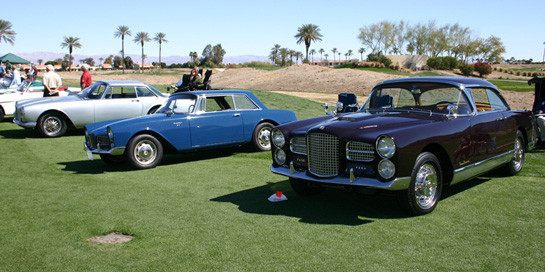
Back in the Rat Pack days, Frank Sinatra bought a Facel Vega and his RP buddies followed suit, starting a mini-craze for these French grande routières among the entertainment elite. The Palm Springs area was thus a fitting place to have a class for these cars. These three (l to r) are a Facel II, a Facellia and an FV4 Typhoon. The latter, owned by Andrew Linskey won the class. The two end cars have Chrysler V-8s, while the Facellia has a 1.6-liter four cylinder engine produced by Pont- à-Mousson, a large French firm better known for their transmissions. Credit: Michael T. Lynch
More wonderful cars that I’ve never seen before. Thank you.
The Aston is much to voluptuous to be called “supermodel gorgeous.” I propose “Marilyn Monroe gorgeous.”
Re: the caption to the Facel photos. The Rat Pack owned Dual Ghias, not Facels.
My red Apollo GT was also on the tour & I took it on the drive instead of my SIATA bcause the windshield wipers worked better, & we were expecting more rain than we actually had on Saturday. Sunday the weather was beautiful so I put the SIATA on the field shown right behind the Fiat Multipla. In total, a beautiful selection of cars at a very wonderful concours
I know Tom Tjaarda. I also wrote a book on Shelby, and while doing that talked to the first two designers of the Series I. The first one was actually a fine arts painter who was bounced out of the project before the first car was built. His design was featured on the cover of Automobile magazine. The second designer was somebody who saw an opportunity to claim he was a designer and took it, with nobody wishing to contradict him (success has many fathers etc. etc.) Then some LV investors saw all the unfinished cars just sitting there and decided to save them and Tjaarda was hired but only got to do a very slight restyling of the nose when his input was rejected. I am sure if Tom had designed it from the beginning it would have looked at least slimmer. As far as I know the cars are still being sold one by one, but you are stuck with the original model year designation.
Another caption comment. There was no connection between the Apollo of Milt Brown and the Intermeccanica Italias other than that Reisner worked on both. The Italia actually came about through Jack Griffith, a Florida car dealer, and ironically had a 273 cu. in. Chrysler engine (as in Barracuda). The original chief engineer was Mark Donohue! Then somehow the coupe versions ended up being built out in Charlotte by Holman & Moody, famous Ford race car builders, but with Ford engines, called the Omegas.Then they got Ford V8s, not sure whether 289s, 302s or 351s but they were sold as Intermeccanicas, nothing to do with Apollo. Who designed the yellow car pictured is a problem–Robert Cumberford, the design commenter of Automobile, claims authorship but some say a reclusive Italian designer, Scaglione, did it. There were several versions of Intermeccanicas and there is a fine book out on them, though I don’t have it, so have to recall all this from memory. Reisner by the way was transplanted from his original Hungary.
re: Sinthesis caption: The car doesn’t use a Flavia chassis; it has a custom sheet metal chassis, with a Flavia engine and subframe, mounted behind the seats for a mid-engine layout, and Fulvia suspension at front. But the car isn’t merely owned by Peter Giacobbi (standing behind the car, tan shirt & hat); he engineered and built the car for himself , while he was working in Torino. It’s a beautiful Tjaarda design, with well-resolved details. However, unlike most design exercises, this was less a show car than a working car for its owner. So it wasn’t slapped together strictly for show; the body is steel, the windows are all safety glass, and it even has a very early airbag in the center of the steering wheel (actuated by compressed air through the hollow steering column). Beyond the fact that the car itself is remarkable, it’s truly remarkable to see a one-off owned and driven by the guy who created it 40 years earlier.